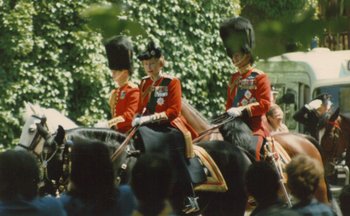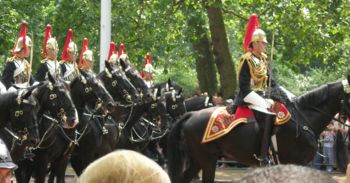影片对白 We have
all felt those emotions in these last few days, so what I say to you now, as
your Queen, and as a grandmother, I say from my heart.
考考你
乘热打铁
5. 24-7
这是一个俚语,意思是"Continuously; unceasingly.
持续不断地,连续地"。一天24小时,一周七天,24-7就用来表示"时时刻刻,不断地"。
6. Go weak at the knees
口语,意为"To be overcome by emotion",例如:This film makes me go weak at the knees.
.
7. At the end of the day
"At the end of day"在这里是个非正式的口语表达,it is something that you say before you say
what you believe to be the most important fact of a
situation(在话已说尽,事情已做完的时候),类似于汉语中"说到底,到头来"。例如:Sure we missed our best player but
at the end of the day, John, we just didn't play well enough to win the game.
此外,at the end of the day 还可以表示"finally",例如:We interviewed many people for the
job, but at the end of the day, we didn't think any of them could handle it.
文化面面观
皇家军队阅兵 & 戴安娜的葬礼
Trooping the Colour
皇家军队阅兵
 |
|
Elizabeth II riding to Trooping
the Colour for the last time in 1986. Since then, she has travelled in a
phaeton carriage. |
Elizabeth II riding to
Trooping the Colour for the last time in 1986. Since then, she has travelled in
a phaeton carriage.Trooping the Colour is a military pageant or ceremony
performed by regiments of the Commonwealth and the British Army. It has been a
tradition of British infantry regiments for centuries and it was first performed
during the reign of Charles II.
On battlefields, a regiment's colours, or flags, were used as rallying
points. Consequently, regiments would have their Ensigns slowly march with their
colours between the soldiers' ranks so that they would recognize what their
regiments' colours looked like.
The importance of the colours was not confined to control during battle. They
represented a regiment's direct link and service to the sovereign, as well as to
the fallen soldiers and officers of that regiment. Its loss, or the capture of
an enemy colour, were respectively considered the greatest shame, or the
greatest glory available on a battlefield. As such, regimental colours are
venerated and paid the highest compliments by officers and soldiers of all
ranks, second only to the Sovereign.
Only battalions of Infantry Regiments of the Line carry Colours. the Royal
Artillery's colours are their guns. Rifle Regiments did not form a Line and thus
never carried Colours. Their Battle honours are carried on their drums.
Trooping the Colours is an old ceremony whereby the battalion would fall in
by Companies and the colour-party would "troop" or march the Colours through the
ranks so that every man would see that the Colours were intact. This was done
before and after every battle. This ceremony has been retained through time and
is today largely ceremonial.
 |
|
Trooping of colour, June 17,
2006. |
Trooping of colour, June 17, 2006.In
the United Kingdom, Trooping the Colour has become closely identified with the
Queen's Official Birthday, and is also known as the Queen's Birthday Parade. It
has marked the official birthday of the Sovereign since 1748, and has occurred
annually since 1820 (except in bad weather, periods of mourning and other
exceptional circumstances). Edward VII moved Trooping the Colour to its June
date, because of the vagaries of British weather.
Trooping the Colour allows the Household Division - Foot Guards and Household
Cavalry - and King's Troop to pay a personal tribute to the Sovereign with great
pomp and pageantry. Crowds at Buckingham Palace, around the Victoria Memorial
and lining The Mall (London) listen to the military bands before and after the
ceremony. Events at Buckingham Palace after the Queen's return include another
march past, a 41-gun salute in the adjacent Green Park, and a flypast by the
Royal Air Force. This is followed by the usual daily Changing of the Guard.
The Queen has attended Trooping the Colour in every year of her reign except
when prevented by a rail strike in 1955. She was once fired at on her way to the
ceremony by a lone assailant. Her 80th birthday in 2006 was marked by an
extended flypast and a feu de joie.